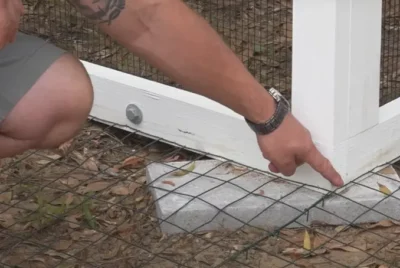Effective Chicken Coop Roofing Strategies to Deter Birds of Prey
One persistent challenge that poultry keepers face is protecting their chickens from birds of prey. These aerial predators, including hawks, eagles, and owls, pose a constant threat to your flock.
To safeguard your chickens and ensure their safety, it’s crucial to implement effective chicken coop roofing strategies. In this article, we will give you some effective techniques and discuss materials to deter birds of prey and create a secure and protected environment for your poultry.
Table of Contents
- What Qualities Should a Good Roof for a Chicken Coop Have?
- Is Using a Single Piece of Plywood for Your Chicken Coop Roof Is Okay?
- Best Materials for Chicken Coop Roofs
- Shingle Roofs for Chicken Coop
- Metal Roofing Sheets for Chicken Coop
- Self-Adhesive Felt for Chicken Coop Roof
- Roll-on Asphalt Materials for Chicken Coop Roof
- Ondura Asphalt Panels for Chicken Coop Roof:
- Plastic Panels for Chicken Coop Roof
- Asphalt Materials for Chicken Coop
- Bitumen Roofing Sheets for Chicken Coop Roof
- Felt Shingles for Chicken Coop Roof
- Living Roof for Chicken Coop Roof
- What Roof Pitch Is Appropriate for a Chicken Coop?
- Predator Proof Your Chicken Coop Roof

What Qualities Should a Good Roof for a Chicken Coop Have?
A good roof for a chicken coop should possess several key qualities to provide adequate protection and comfort for your chickens. Here are the essential qualities to look for:
- Weather Resistance: The roof should offer protection against different weather conditions, including snow, rain, wind, and sunlight. It should keep the coop’s interior dry and shielded from the elements.
- Durability: The roof material should be sturdy and capable of withstanding the test of time. It should resist wear and tear, as well as damage from environmental factors, such as UV rays and extreme temperatures.
- Moisture Barrier: A good roof should effectively keep moisture out of the coop. Moisture can lead to damp bedding, mold growth, and unhealthy living conditions for chickens. Ensure that the roof doesn’t allow water to seep through or accumulate on its surface.
- Ventilation: Adequate ventilation is important to maintain good air quality and prevent condensation inside the coop. Consider incorporating vents or a ridge vent to allow for proper airflow without creating drafts.
- Insulation (Optional): Depending on your climate, you may want a roof with insulation to help regulate temperature inside the coop. Insulation can keep the chicken coop warmer in the winter days and cooler in the summer days.
- Predator Protection: While not a feature of the roof itself, it’s important to ensure that the roof is properly integrated with the coop’s walls and that there are no gaps or openings where predators can gain access.
- Easy Maintenance: A good roof should be relatively low-maintenance. Regular inspections should be sufficient to identify and address any issues like loose shingles or damaged areas.
- Overhangs/Eaves: Extending the roof slightly beyond the walls with overhangs or eaves can help protect the coop’s exterior from rain and reduce the risk of water seeping into the walls or foundation.
- Fire Resistance (Optional): Depending on your location and local building codes, you may want to consider a fire-resistant roofing material to enhance safety.
Read also: Hawk-Proofing Your Coop: Essential Tips for Poultry Owners

Is Using a Single Piece of Plywood for Your Chicken Coop Roof Is Okay?
Using a single piece of plywood for your chicken coop roof can be acceptable if you take the right precautions. Plywood alone is not an ideal roofing material, as it’s vulnerable to moisture damage, rot, and warping.
To make it work, cover the plywood with a weather-resistant material such as asphalt shingles, metal roofing, or corrugated plastic sheets.
Proper installation, including secure attachment to the coop’s frame and sealing to prevent leaks, is crucial. Regular maintenance is also important to ensure the protective covering remains intact.
Remember that the suitability of this approach may depend on your local climate, as plywood is more susceptible to damage in humid or wet conditions.
Best Materials for Chicken Coop Roofs
Shingle Roofs for Chicken Coop
Shingle roofs are a durable and popular choice for chicken coop roofing. They are widely available and come in different colors and styles, allowing you to choose an aesthetic that suits your preferences.
Shingles are known for longevity, often providing many years of service without significant maintenance. They are particularly well-suited for chicken coops in varied weather conditions, as they can effectively withstand rain, snow, and sunlight.
While shingle roofs may be a bit more expensive than some other materials, their durability and aesthetic appeal make them a reliable option for chicken coop roofing.
Metal Roofing Sheets for Chicken Coop
Metal roofing sheets, typically made from galvanized steel or tin, are a practical choice for chicken coop roofs, especially in regions with mild or warm climates. They are affordable, readily available, and known for their durability.
Metal roofs are low-maintenance and can withstand various weather conditions, making them suitable for areas with rain and heat.
However, in colder climates, they can be prone to condensation issues, which can lead to moisture problems inside the coop. I recommend proper ventilation and insulation when using metal sheets for chicken coop roofing to mitigate condensation concerns.

Self-Adhesive Felt for Chicken Coop Roof
Self-adhesive felt is a cost-effective roofing material suitable for chicken coop roofs, particularly for those with flat or low-pitched roofs. This material is easy to work with, making it accessible for DIY installations. It is often used in garden buildings and small structures like chicken coops.
However, self-adhesive felt may not be as durable as other roofing materials, and it may need more frequent maintenance and replacement over time. While it offers affordability and simplicity, its lifespan may be shorter than materials like metal or shingles.
Roll-on Asphalt Materials for Chicken Coop Roof
Roll-on asphalt materials, typically used with a wood base, are a common choice for low-cost chicken coops. This type of roofing is affordable and straightforward to install, making it suitable for DIY enthusiasts.
However, it’s important to note that the quality of roll-on asphalt materials can vary, and lower-quality options may have reduced durability.
Over time, these materials may require maintenance and replacement, especially in harsh weather conditions. If using roll-on asphalt materials for a chicken coop roof, periodic inspections and repairs may be necessary to ensure they provide adequate protection.
Ondura Asphalt Panels for Chicken Coop Roof:
Ondura asphalt panels are a more durable option compared to roll-on asphalt materials. These corrugated panels offer better longevity and resistance to the elements. They are often chosen for their durability and ease of installation, making them suitable for chicken coop roofs.
However, like other asphalt-based materials, they may still require some maintenance over time, and their performance can be affected by weather or climate conditions.
To ensure the best results, I advise installing Ondura panels on top of a plywood base or insulation to enhance their lifespan and protect your coop from potential leaks and condensation issues.
Plastic Panels for Chicken Coop Roof
Plastic panels, such as corrugated plastic or polycarbonate sheets, are affordable and lightweight roofing options for chicken coops. They are easy to work with and require just minimal maintenance.
Corrugated plastic sheets are cost-effective and widely available, while polycarbonate sheets offer better durability and weather resistance. However, plastic panels may not be as sturdy as other materials and can be susceptible to hail and high wind damage.
To maximize their lifespan and protect your coop from condensation, I advise also installing them on top of a plywood base or using proper insulation. While they have their limitations, plastic panels are a budget-friendly choice for coop owners looking for a practical roofing solution.
Asphalt Materials for Chicken Coop
Asphalt roofing materials, such as roll-on asphalt paper or corrugated panels, offer an economical roofing solution for chicken coops. They are easy to install and widely available.
Roll-on asphalt paper, often used on low-cost coops, is inexpensive but may be less durable. On the other hand, corrugated asphalt panels, like Ondura panels, provide better durability.
However, asphalt roofing materials may require maintenance over time and are less suitable for extremely cold or wet climates.
To enhance their performance, I advise installing them on top of a plywood base or insulation to prevent condensation issues and improve their lifespan.

Bitumen Roofing Sheets for Chicken Coop Roof
Bitumen roofing sheets, commonly known as bitumen corrugated sheets, are a popular choice for chicken coop roofing. These sheets are lightweight, sturdy, and cost-effective. They are relatively easy to install, making them suitable for DIY projects.
Bitumen sheets come in various colors, allowing you to choose the one that best suits your preferences. However, it’s essential to note that bitumen sheets may not be as durable as other roofing materials and may require maintenance over time.
While they offer solid performance in protecting against rain and weather, you should be prepared for occasional upkeep to ensure the longevity of their coop’s roof.
Felt Shingles for Chicken Coop Roof
Felt shingles are an aesthetically pleasing roofing option for chicken coops. These shingles are available in various styles, shapes, and colors, allowing coop owners to create a visually appealing coop.
While they may be more expensive than some other roofing materials, felt shingles are known for their durability and can provide up to 20 years of maintenance-free life. They are relatively easy to install and lightweight, making them suitable for DIY enthusiasts.
However, felt shingles may require occasional maintenance and repair and may not be as budget-friendly as other roofing options. If you want to enhance your coop’s visual appeal while prioritizing durability, felt shingles are an excellent choice.
Living Roof for Chicken Coop Roof
A living roof, also known as a green roof, is a unique and environmentally friendly option for chicken coop roofing. It involves planting vegetation on the coop’s roof, providing natural insulation and improving air quality inside the coop.
Living roofs have a distinctive natural aesthetic, making them a choice for those looking to create an attractive coop. However, they come with higher initial costs and more complex installation requirements.
You need to plan and budget carefully for installing a living roof. While they offer several benefits, including insulation and improved air quality, living roofs may require ongoing maintenance to ensure the vitality and health of the vegetation, making them a choice for those willing to invest in sustainable and visually appealing roofing solutions.
What Roof Pitch Is Appropriate for a Chicken Coop?
A roof pitch of 4:12 (which equates to an 18.43-degree angle) is generally considered appropriate for a chicken coop. This pitch strikes a good balance between shedding water efficiently, preventing pooling, and providing sufficient interior space for the coop.
A 4:12 pitch allows rain and snow to run off the roof effectively, reducing the risk of leaks and water damage. It also provides ample headroom inside the chicken coop and makes installing ventilation and windows easier.
While you can choose other pitch ratios based on your preferences and local climate, a 4:12 pitch is a practical and commonly used choice for chicken coops.

Predator Proof Your Chicken Coop Roof
Protecting your chickens from birds of prey is a crucial aspect of responsible poultry keeping. By implementing these effective chicken coop roofing strategies, you can create a secure and safe space for your flock, providing them with the safety they need to thrive.
With the right precautions in place, you can enjoy the benefits of chicken-keeping without the constant worry of airborne predators.
For a comprehensive guide to advancing your chicken coop security, be sure to read “A Complete Guide to Advance Chicken Coop Security Strategies.” Your chickens will thank you for it!





